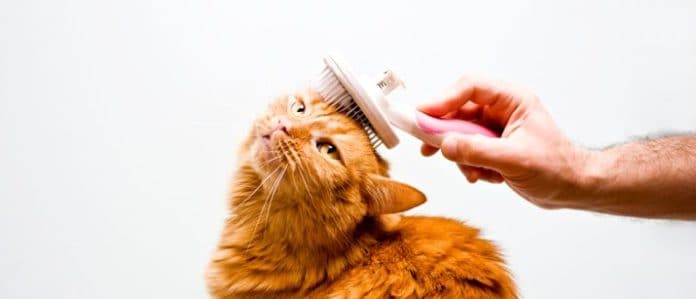Cats are neat freaks. In fact, if you’re a cat owner, you know firsthand that your cat is a fastidious groomer. After all, it seems to spend most of its life either sleeping or grooming!
But as gung-ho as your cat is about keeping itself groomed and clean, the truth is that it could still use a bit of help from you.
Grooming is about more than just keeping your cat looking good. Grooming your cat on a regular basis will also help you to keep an eye on its health. And grooming your cat can even help to prevent feline health issues such as digestive problems caused by hairballs. Regular grooming can also help to improve the health of your cat’s skin and coat.
GETTING STARTED
If you’re already a cat owner, this probably goes without saying: Don’t just snatch up your cat one day and commence to grooming if you’ve never groomed the cat before. The outcome is likely to be unpleasant for the both of you.
Instead, slowly accustom the cat to the process of grooming.
Pick a time when the cat is relaxed and content – after eating, perhaps. Then start with short grooming sessions of maybe 5 to 10 minutes. Pet and praise the cat as you’re grooming, and maybe even offer a treat at the end of the session. And if the cat begins to show signs that it’s none too happy about what’s happening, stop for now. You can try it again later.
With time, the cat will become accustomed to the process, and will likely come to enjoy it.
BRUSHING BASICS
Regular brushing offers benefits such as dead hair and dirt, and removing or preventing mats and tangles. But do it right, or you’ll end up with a cantankerous kitty on your hands!
Always brush in the direction that the hair naturally lays, never against the ‘grain.’ And be extra gentle around the belly and chest.
For shorthaired cats:
- Start with a fine-toothed metal comb. Run it through the cat’s fur from head to tail tip. Watch for small pepper-like specks that could indicate the presence of cat fleas.
- Use a bristle or soft rubber brush next to remove loose hair.
For longhaired cats:
- Start with a wide-toothed comb to remove debris that may be caught in the cat’s coat. Carefully untangle any knots.
- Next use a wire brush or a bristle brush to remove loose hair.
- Consider using a toothbrush to brush around the cat’s face.
And if you encounter matting in the cat’s fur, don’t try to cut it out; one or both of you may end up getting hurt.
Brushing twice a week should be plenty for most shorthaired cats, while a longhaired cat may need brushing every day.
BATH TIME (SAY IT ISN’T SO)
Does the idea of giving your cat a bath send shivers of fear down your spine? Understandable! It’s well known that most cats aren’t particularly fond of water. You may even have been witness to a vivid demonstration of this fact in times past.
Luckily, cats don’t often need the help of a full-blown bath.
But on occasion, your cat’s coat might become sticky or dirty to a degree that the old tongue-bath just isn’t going to cut it. So you’ll have to get involved. Fortunately, though, bath time doesn’t have to be a time of terror for the both of you – if you do it right:
- Start by making the water temperature pleasant. It should be warm – not hot, and not cold.
- Use a shampoo that’s made specifically for use with cats, and labeled accordingly.
- Use a sink or tub in which you’ve placed a rubber bath mat, filled to a depth of just 3 or 4 inches.
- Gently wet the cat down using a spray hose, but DO NOT spray or pour water directly on the cat’s head – you don’t want to spray or pour into the cat’s eyes, ears or nose. If you don’t have a spray hose, use an unbreakable pitcher.
- Start at the cat’s head, and gently work in the shampoo from head to tail.
- Rinse gently but thoroughly, making sure that all the shampoo is rinsed out. Again, be sure to avoid spraying or pouring water directly on the cat’s head.
- Gently pat dry with a large towel.
And one last tip: If your cat’s nails need clipping, do it BEFORE bath time!
PEDICURE, PLEASE
Getting your cat to accept having it’s claws trimmed by you really shouldn’t be too difficult, IF you approach it properly.
Start out by spending some time just training your cat to be comfortable and accepting of having her feet handled. Begin to massage its feet on a daily basis. Do that by running your hand along its leg, and then very gently pressing with your thumb on the pad of each toe, causing the claw to extend. After a week or two the cat will likely become comfortable with its daily foot massage.
Once the cat is comfortable with the massaging, it’s OK to clip. Use a quality, sharp clipper or nail scissors specifically designed for use on cats. Cut parallel to the flat of the claw, and clip off only the white tip. Be VERY careful to avoid the quick, which usually appears as a pinkish area that you can see through the translucent claw.
IT’S NICE TO BE NEEDED
Compared to certain other pets, cats are relatively low maintenance – a nice perk for cat lovers. But like all of us, your cat could use a helping hand now and then. Independent creature though your cat may be, it still needs your help in remaining happy and healthy.
And that’s kind of a perk, too, wouldn’t you agree?









